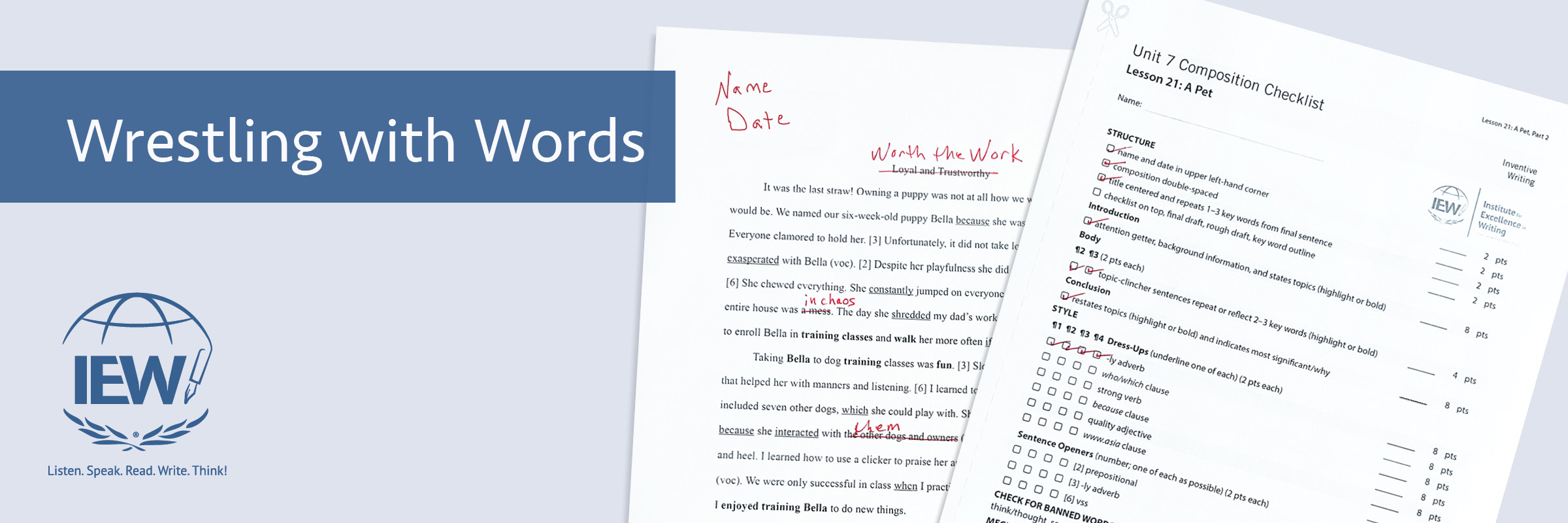
“Why do I have to underline the dress-ups?” Any parent or teacher who has used the Structure and Style® methodology for any length of time has undoubtedly heard these words, usually in a whiny tone. Sometimes you may find yourself asking the same thing: why do my students have to underline the dress-ups? Does it really matter? We at IEW would answer that question with a resounding YES! Requiring students to indicate their dress-ups by underlining them benefits not only the teacher but the student as well. Let’s look at the reasons why this is true.
The most obvious benefit of underlining dress-ups for teachers and parents is that it makes the dress-ups easy to spot, and therefore the composition is easier to grade. If a student hands in a paper with no underlines at all, you can give it back right away with a smile, stating, “Oops! It looks like you forgot something.” When I am marking students’ papers, I start by counting the number of underlines in the paragraph. If the number of underlines is less than the number of dress-ups on their checklist, I hand it back to be completed. Requiring students to underline dress-ups also helps the teacher to check the students’ understanding of grammar. Keeping the goal of EZ+1 in mind, you can evaluate if the student is ready to add the next dress-up or if you have advanced their checklist too fast and need to cut it back. Lastly, requiring students to underline dress-ups clearly communicates to them your standard of excellence, thus avoiding one of the Four Deadly Errors of Teaching Writing: unclear expectations. However, this requirement has advantages for students as well.
Whether they realize it or not, underlining dress-ups serves several purposes for students. First, it reinforces the grammar concepts in the context of use. Anna Ingham called this teaching “at the point of need.” When students connect grammar instruction with their writing, they see the importance of knowing how their language works. For further instruction on connecting grammar instruction and writing, listen to Andrew Pudewa’s talk But . . . but . . . but . . . What about Grammar? Indicating dress-ups also increases students’ confidence. As they continue to practice the stylistic techniques, they will begin to include them intuitively in their writing. They realize that what was once difficult is now easy. This encourages them to persevere when they are struggling with the next hard thing to learn, knowing that with time and practice it will become easier. Most importantly, signaling the use of dress-ups builds the habit of “doing what you check and checking what you do.” It holds them accountable to the standard, which is an important practice no matter what future career they enter. Since the requirements are clear, students can easily discern when the assignment is complete, giving them the satisfaction of a job well done. Julie Walker and Andrew Pudewa discuss this further in “IEW’s Checklist Motivates for Success” (Episode 394). Although it may not be immediately clear, insisting that students signal their dress-ups profits them not only in the short term but also throughout life.
While it may seem to be picky or demanding, asking students to indicate their dress-ups benefits the teacher and student in many ways, both immediate and long-term. The most important lesson learned from this practice is the character aspect: perseverance to meet a standard of excellence, a rare quality today. So, the next time your students whine about having to underline their dress-ups, remind them that to learn to use tools one must practice. As Jill Pike states, “Wrestling with . . . words will pay off in the future.” That payoff is the skill of being a confident and competent communicator and thinker!
by Deanne Smith
